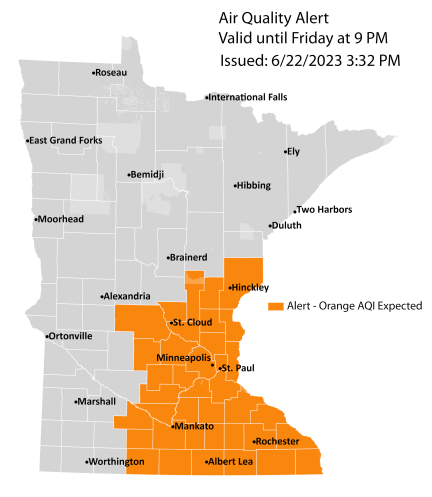Air quality is expected to reach the orange AQI category in the rest of central and southern Minn., which is unhealthy for sensitive groups.

An air quality alert for east-central and southeastern Minn. remains in effect from noon on Thursday, June 22, through 9 p.m. on Friday, June 23. The affected area includes east central and southeastern Minn., and the tribal nation of Prairie Island.
Ground-level ozone is expected to be high during the afternoon hours on Thursday and Friday across east-central and southeastern Minn. Mostly sunny skies, warm temperatures, and low humidity will create an environment favorable for two types of pollutants (volatile organic compounds and nitrogen oxides) to react in the air to produce ground-level ozone. These pollutants will be transported by southerly winds from the Chicago area, northeast Iowa, and southeast Minn. Ozone will be highest during the afternoon and early evening hours when sunshine is most abundant, and temperatures are highest. Ozone will be low in the morning, late evening, and overnight. A low pressure system will arrive over the weekend to bring an end to the high ozone concentrations.
Ozone levels are expected to reach the orange air quality index (AQI) category, a level considered unhealthy for sensitive groups, across central and southern Minn. The alert area includes the Twin Cities, Albert Lea, Rochester, Hinckley, St. Cloud, Mankato, Winona, and the tribal nation of Prairie Island. In the orange area, sensitive groups should limit prolonged outdoor exertion.
For the orange air quality area, the air is considered unhealthy for sensitive groups. People who are more likely to be to be affected when ozone pollution reaches an unhealthy level include:
- People who have asthma or other breathing conditions like chronic obstructive pulmonary disease (COPD), chronic bronchitis, and emphysema.
- Children and teenagers.
- People of all ages who are doing extended or heavy, physical activity like playing sports or working outdoors.
- Some healthy people who are more sensitive to ozone even though they have none of the risk factors. There may be a genetic base for this increased sensitivity.
Health effects: Unhealthy ozone levels can aggravate lung diseases like asthma, emphysema, and COPD. When the air quality is unhealthy, people with these conditions may experience symptoms like difficulty breathing deeply, shortness of breath, throat soreness, wheezing, coughing, or unusual fatigue. If you are experiencing any of these symptoms, use your inhalers as directed and contact your health care provider.
Take precautions: Everyone should take precautions when the air quality is unhealthy.
- Take it easy and listen to your body.
- Limit, change, or postpone your physical activity.
- If possible, stay away from local sources of air pollution like busy roads and wood fires.
- If you have asthma, or other breathing conditions like COPD, make sure you have your relief/rescue inhaler with you.
- People with asthma should review and follow guidance in their written asthma action plan. Make an appointment to see your health provider if you don’t have an asthma action plan.
Pollution reduction tips: Ozone is produced on hot, sunny days by a chemical reaction between volatile organic compounds and oxides of nitrogen.
- Reduce vehicle trips and fill-up the gas tank at dawn or dusk.
- Encourage use of public transport, or carpool, when possible.
- Postpone use of gasoline powered lawn and garden equipment on air alert days. Use battery or manual equipment instead.
- Avoid backyard fires.
Stay informed
- Visit MPCA’s Air Quality Index webpage for information on current air quality conditions in your area.
- Sign up for daily air quality forecasts and alert notifications though EnviroFlash.
- Download the EPA AirNow mobile app from the Apple App Store or the Google Play Store.
- Visit the MPCA's Air quality and health webpage for information about health and indoor and outdoor air quality and how to prevent air pollution.